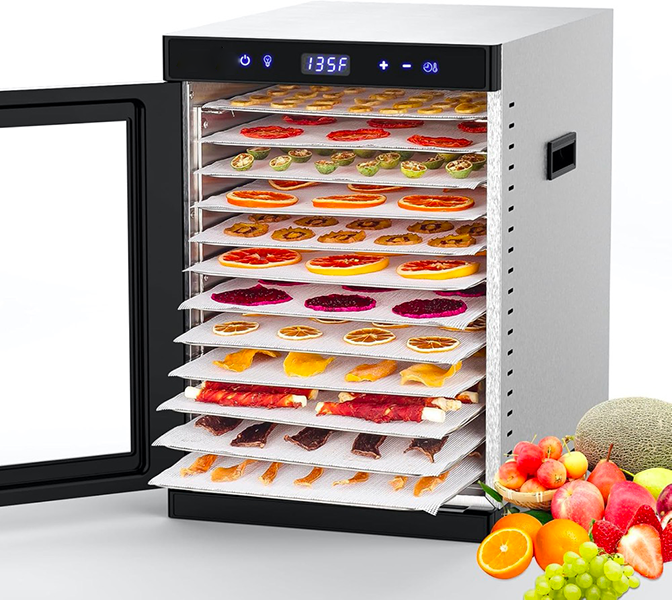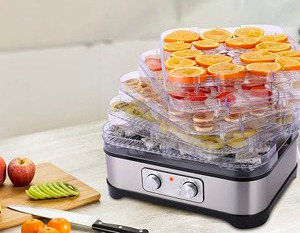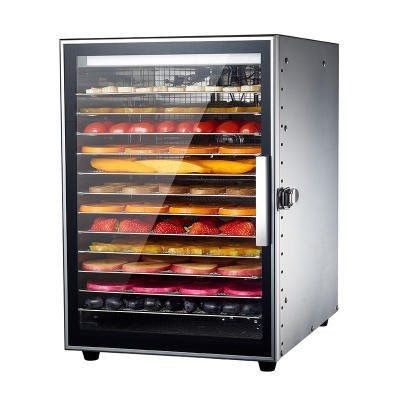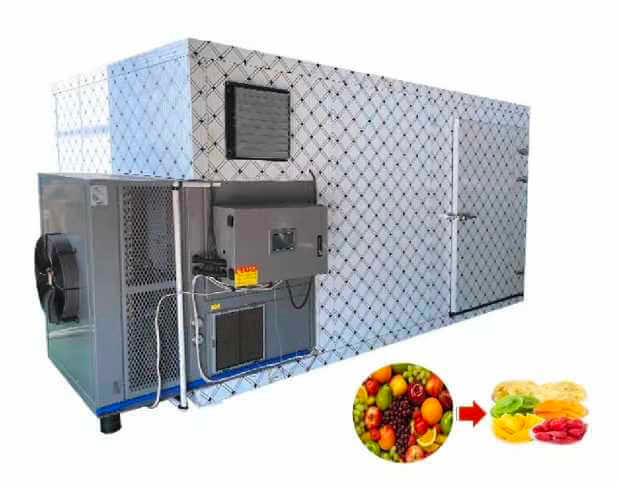
Content Menu
● What Is a Food Dehydrator?
● How Does a Food Dehydrator Work?
● Benefits of Using a Food Dehydrator
● Types of Food Dehydrators
● Energy Efficiency in Food Dehydration
● Common Applications of Food Dehydrators
● Does a Heat Pump Dryer Need Ventilation?
● Tips for Effective Food Dehydration
● Popular Foods to Dehydrate
● Safety Considerations When Using Food Dehydrators
● Conclusion
● Frequently Asked Questions
>> 1. What types of foods can be dried using a food dehydrator?
>> 2. How long does it take to dehydrate food?
>> 3. Can I dehydrate wet foods?
>> 4. Is it safe to eat dried foods?
>> 5. How should I store my dried foods?
Food dehydration is a time-honored method of preserving food, and with the advancements in technology, food dehydrators have become an essential tool for both home cooks and industrial food processors. This article will explore the workings of food dehydrators, their benefits, types, and applications while addressing a common question: Does a heat pump dryer need ventilation to work?

What Is a Food Dehydrator?
A food dehydrator is an appliance designed to remove moisture from food through the application of heat and airflow. By lowering the moisture content, dehydrators help prevent the growth of bacteria, yeast, and mold, extending the shelf life of various foods. Unlike traditional cooking methods that can destroy nutrients, dehydrators preserve essential vitamins and minerals by operating at lower temperatures.
How Does a Food Dehydrator Work?
Food dehydrators utilize a combination of heat and airflow to effectively remove moisture from food. The process typically involves:
- Heat Source: The dehydrator has built-in heating elements that raise the temperature inside the unit. This heat is crucial for drawing out moisture from the food.
- Air Circulation: A fan circulates warm air evenly throughout the dehydrator. Proper airflow is essential to ensure uniform drying and prevent spoilage.
- Trays and Racks: Food is placed on trays or racks that allow air to circulate freely around the items. This design facilitates even dehydration.
- Temperature Control: Many modern dehydrators come with adjustable temperature settings, allowing users to customize the drying process based on the type of food being preserved.
Benefits of Using a Food Dehydrator
Using a food dehydrator offers numerous advantages:
- Nutrient Preservation: Dehydration retains more vitamins and minerals compared to other preservation methods like canning or freezing.
- Extended Shelf Life: Dried foods can last significantly longer than their fresh counterparts, making them ideal for long-term storage.
- Cost-Effectiveness: Purchasing seasonal produce in bulk and dehydrating it can save money compared to buying out-of-season or processed foods.
- Healthy Snacking: Dehydrated fruits and vegetables make nutritious snacks free from preservatives and added sugars.
- Versatility: Food dehydrators can be used for a variety of foods, including fruits, vegetables, meats, herbs, and even pet treats.
Types of Food Dehydrators
Food dehydrators come in various designs, each suited for different applications:
- Stackable Tray Dehydrators: These models consist of multiple trays stacked on top of each other. They are ideal for small batches of fruits or vegetables but may require rotating trays for even drying.
- Shelf Dehydrators: Equipped with shelves that slide in and out, these units are easier to load and unload. They are suitable for larger quantities of food.
- Conveyor Belt Dehydrators: Commonly used in industrial settings, these machines continuously move food through drying zones with controlled temperature and humidity settings.
- Drum Dehydrators: These units use a rotating drum to dry liquid or slurry foods quickly. They are efficient for producing flakes or powders from high-viscosity materials.

Energy Efficiency in Food Dehydration
Food dehydrators are generally more energy-efficient than conventional ovens. While an oven may consume significantly more power over extended periods, a dehydrator typically operates at lower wattages. For instance, running a 1000W dehydrator for 12 hours consumes less energy than using a 5000W oven for the same duration. This efficiency makes dehydrators an environmentally friendly choice for preserving food.
Common Applications of Food Dehydrators
Food dehydrators are versatile tools used across various sectors:
- Home Use: Individuals use them to create healthy snacks like dried fruits, vegetable chips, jerky, and fruit leathers.
- Commercial Use: Restaurants and food manufacturers utilize dehydrators to produce dried ingredients for soups, snacks, and meal kits.
- Emergency Preparedness: Dried foods are lightweight and have long shelf lives, making them ideal for emergency supplies or camping trips.
Does a Heat Pump Dryer Need Ventilation?
Heat pump dryers operate on principles similar to those of food dehydrators but are designed for laundry rather than food preservation. One significant advantage of heat pump dryers is that they do not require external ventilation. Instead, they recycle warm air within the unit to dry clothes efficiently. This feature allows them to be installed in various locations without needing ductwork or vents.
The absence of ventilation means that heat pump dryers can be placed in smaller spaces or apartments where traditional vented dryers cannot fit. Additionally, this design reduces energy consumption by recirculating air rather than expelling it outside.
Tips for Effective Food Dehydration
To achieve optimal results when using a food dehydrator:
- Uniform Slicing: Cut fruits and vegetables into uniform sizes (no thicker than 1/4 inch) to ensure even drying.
- Pre-treatment: Some foods benefit from pre-treatment methods like blanching or soaking in lemon juice to enhance flavor and color retention.
- Proper Storage: Store dried foods in airtight containers away from light and moisture to prolong their shelf life.
- Regular Maintenance: Clean your dehydrator regularly to prevent buildup on heating elements and fans that could affect performance.
Popular Foods to Dehydrate
Certain foods lend themselves particularly well to dehydration due to their natural sugar content or low moisture levels. Here are some popular options:
- Fruits: Apples, bananas, strawberries, mangoes, and pineapples are favorites among home dehydrators. Their natural sugars intensify during the drying process, creating delicious snacks.
- Vegetables: Carrots, bell peppers, zucchini, tomatoes (especially sun-dried), and mushrooms can be dried for use in soups or stews later on.
- Herbs: Basil, oregano, thyme, rosemary, and parsley retain their flavors well when dried; they can be used in cooking or as garnishes.
- Meats: Jerky made from beef or turkey is popular among outdoor enthusiasts as it provides high protein content without refrigeration needs.
Safety Considerations When Using Food Dehydrators
While using a food dehydrator is generally safe, there are several safety considerations to keep in mind:
- Avoid Cross-contamination: Always wash hands before handling food items. Use separate utensils for raw meats versus fruits or vegetables to prevent cross-contamination.
- Monitor Drying Times: Over-drying can lead to hard textures that may not be palatable; under-drying can result in spoilage. Use recommended drying times as guidelines but adjust based on your specific model's performance.
- Check Storage Conditions: Ensure that dried foods are stored properly—moisture can lead to mold growth if not sealed correctly after dehydration.
Conclusion
Food dehydrators represent an efficient method for preserving food while maintaining its nutritional value. With various types available catering to different needs—whether at home or in commercial settings—these appliances have become indispensable tools in modern kitchens. The ability of heat pump dryers not to require ventilation further emphasizes the versatility of dehydration technology across different applications.

Frequently Asked Questions
1. What types of foods can be dried using a food dehydrator?
- Fruits, vegetables, meats (jerky), herbs, flowers, and even pet treats can be effectively dried using a food dehydrator.
2. How long does it take to dehydrate food?
- Drying times vary depending on the type of food being dried and its moisture content but generally range from several hours to overnight.
3. Can I dehydrate wet foods?
- Wet foods should be pre-treated (e.g., blanched) before dehydration to achieve better results; otherwise, they may not dry properly.
4. Is it safe to eat dried foods?
- Yes! As long as proper dehydration techniques are followed—ensuring low moisture content—dried foods are safe to eat and retain their nutrients.
5. How should I store my dried foods?
- Store dried foods in airtight containers in a cool, dark place away from moisture to maximize their shelf life.












